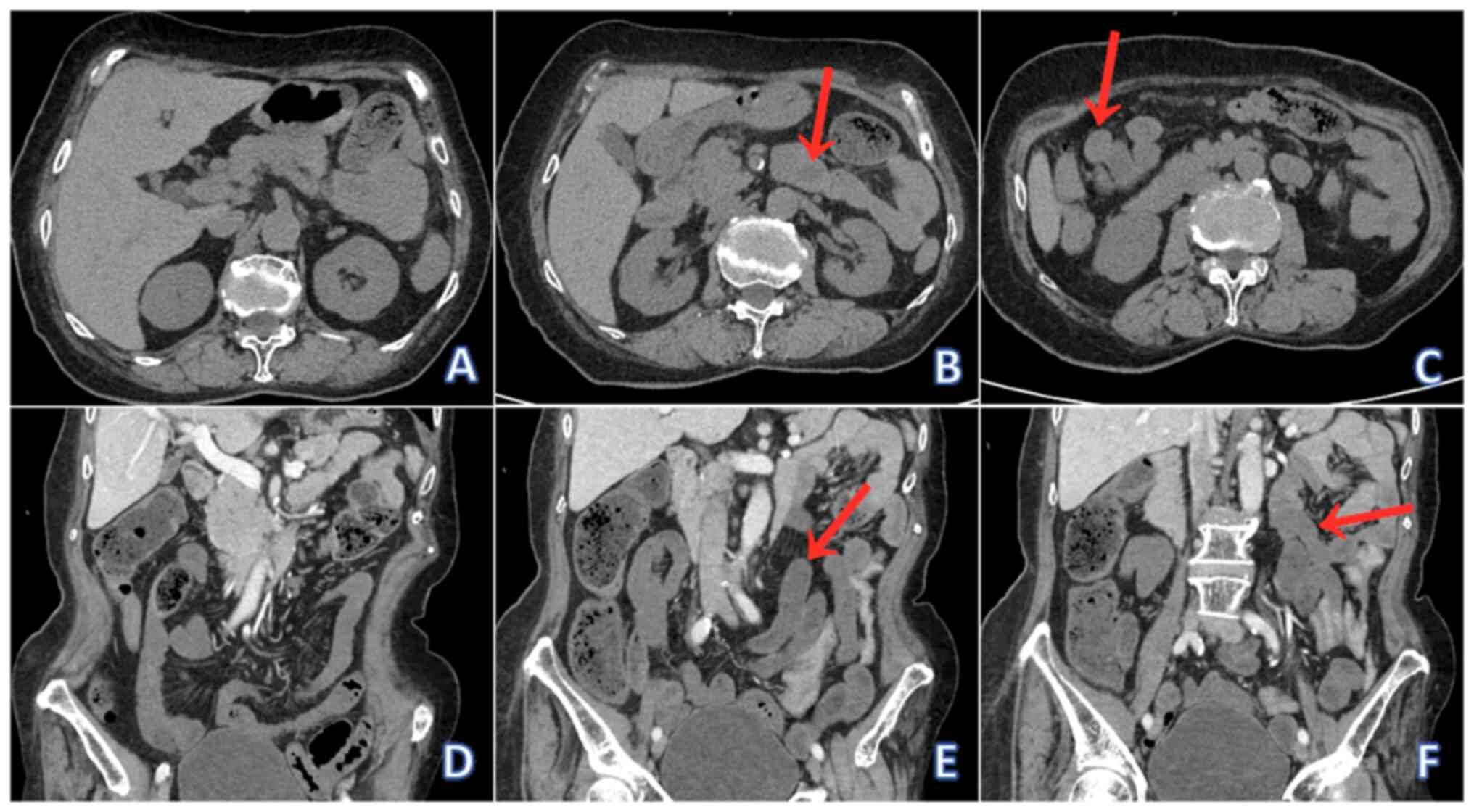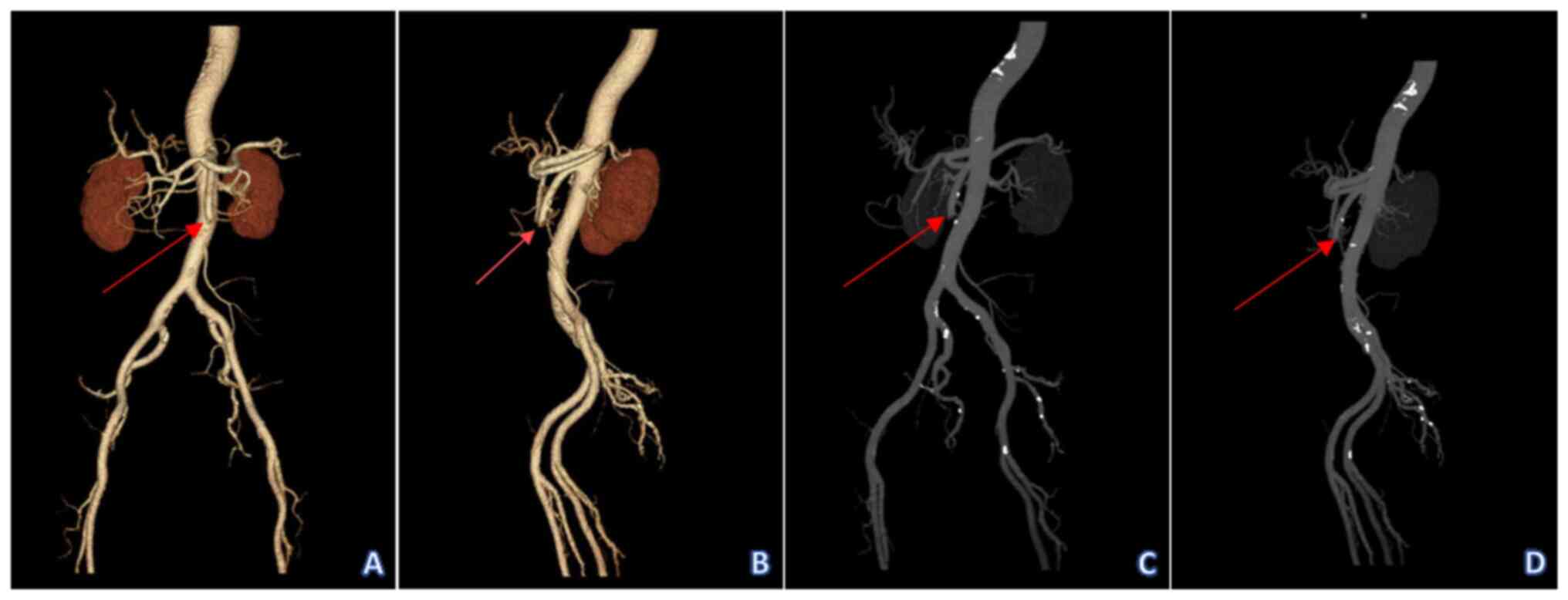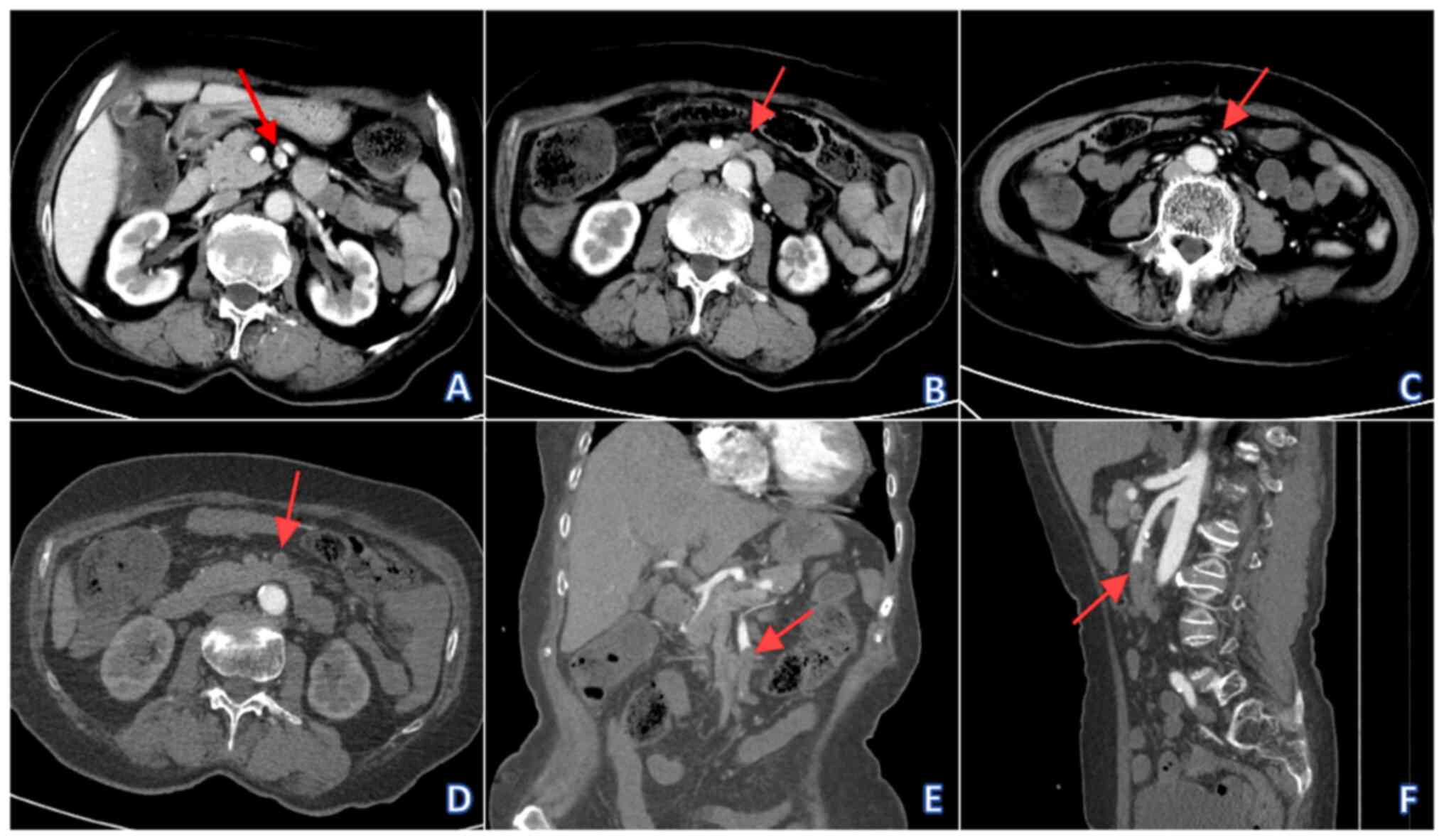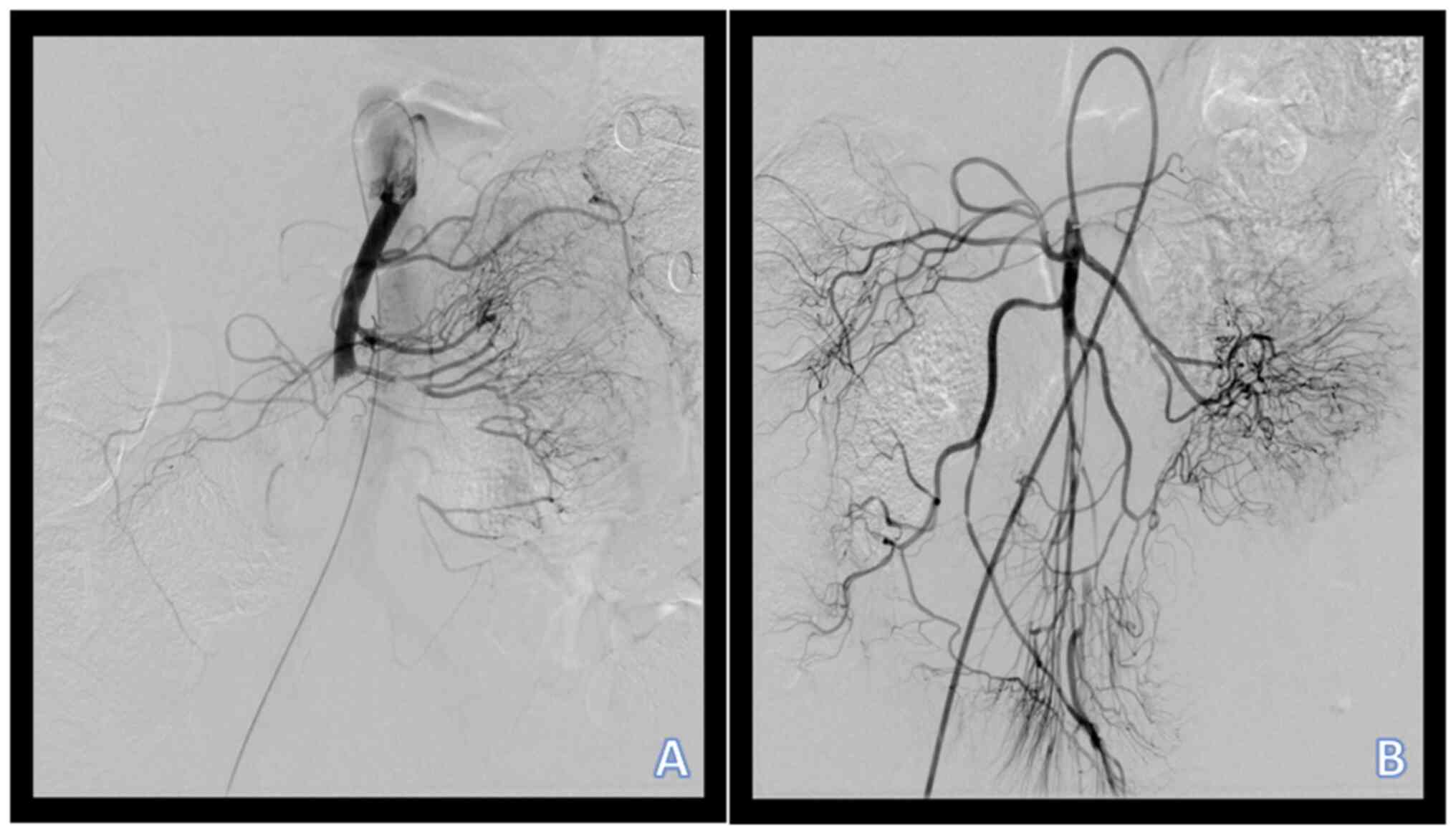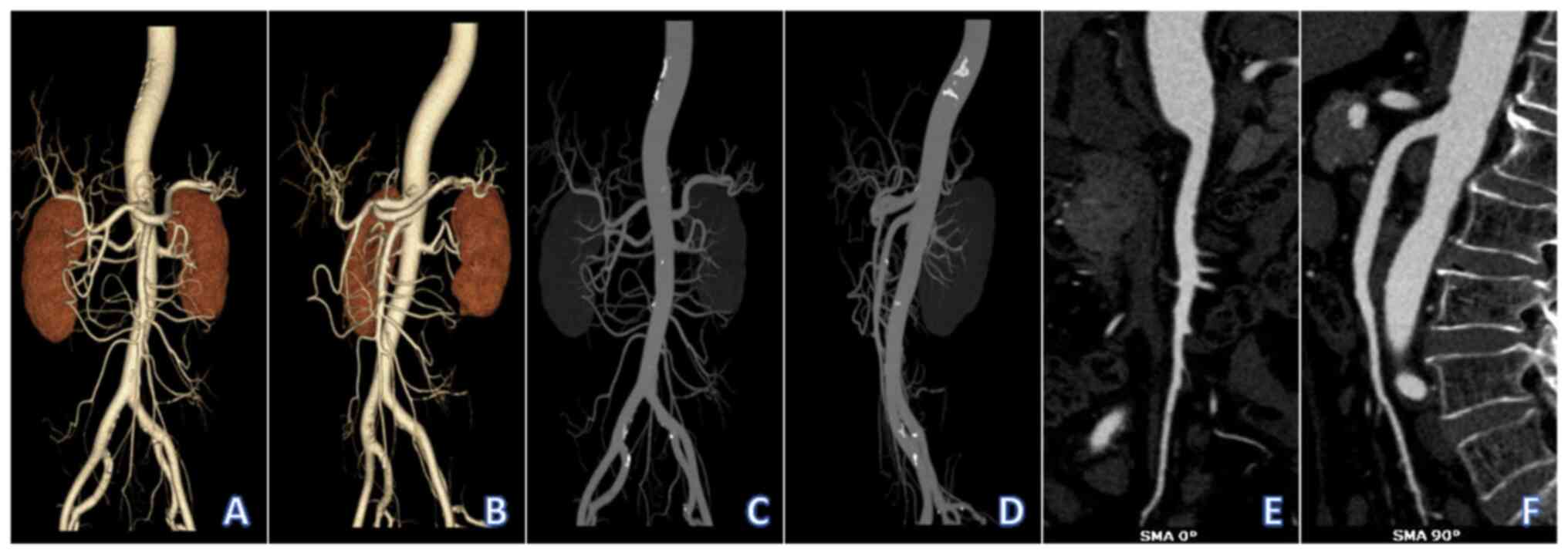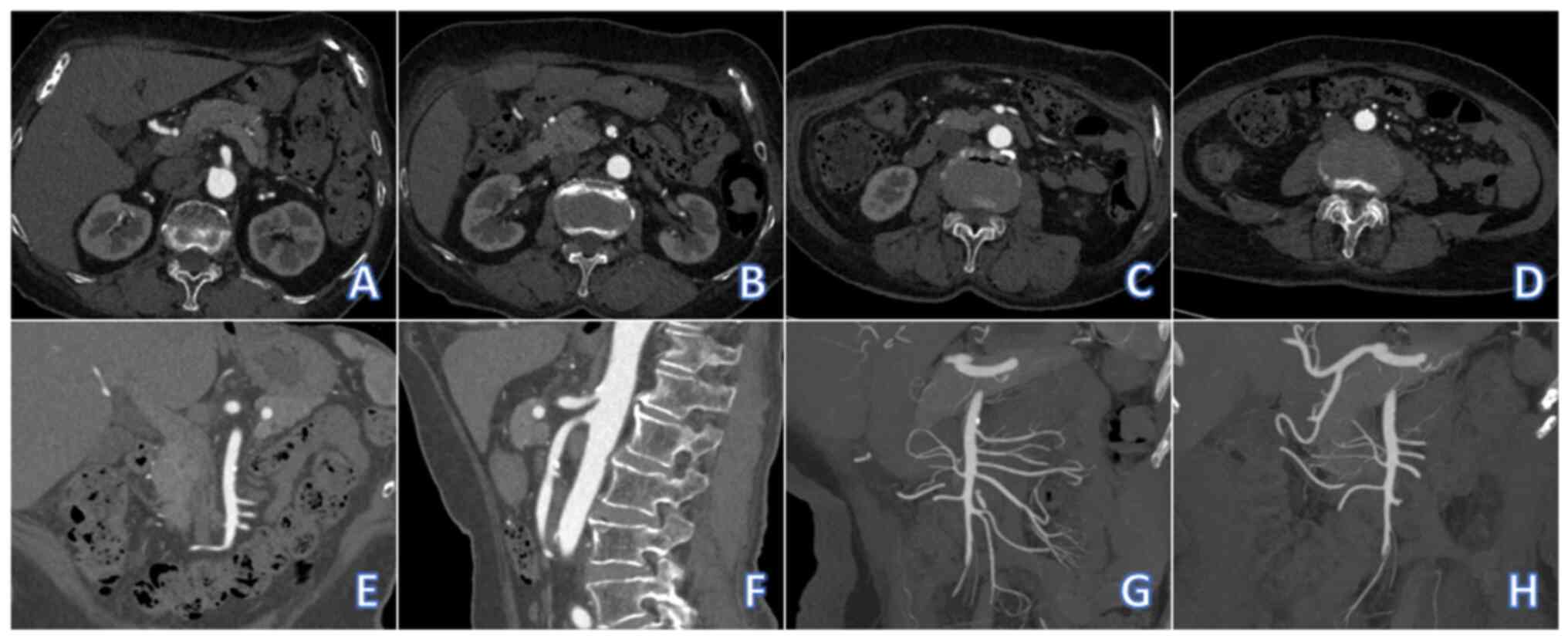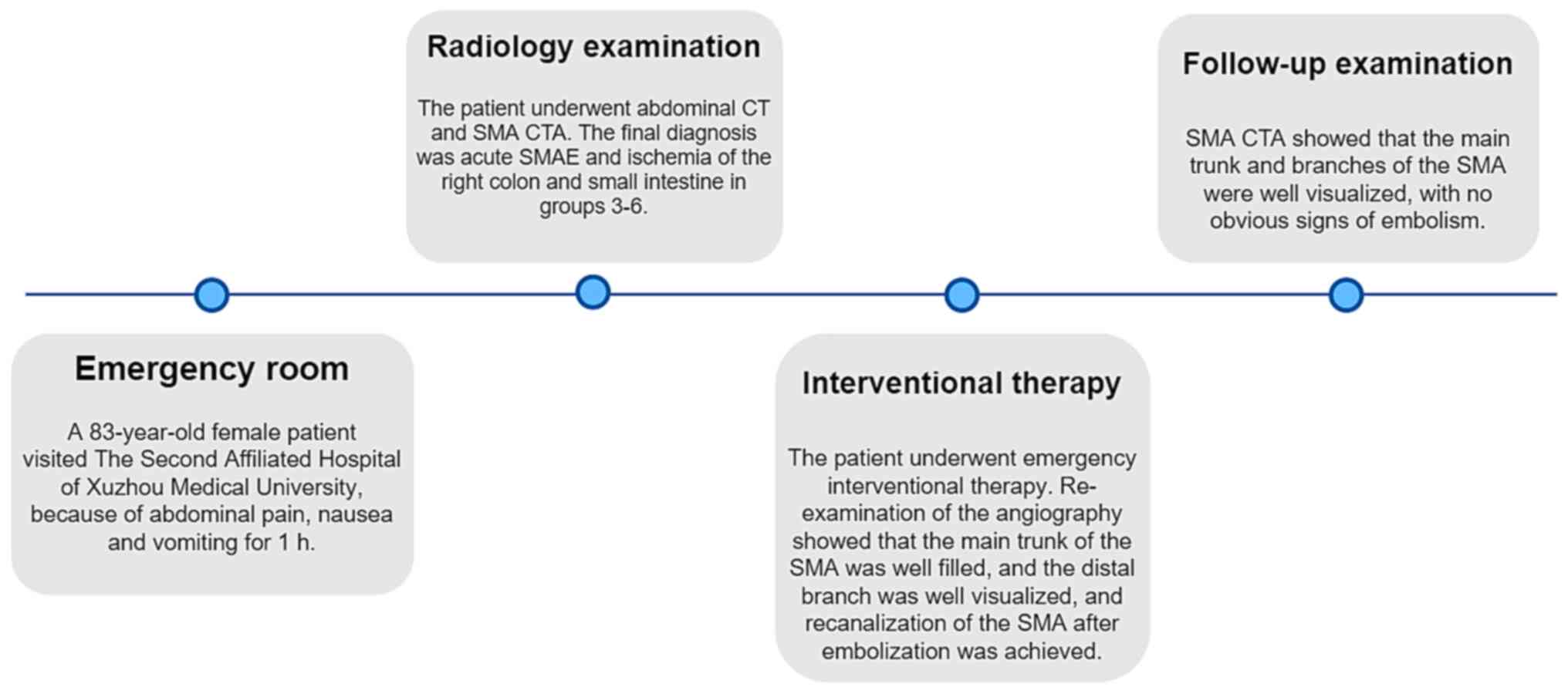Acute superior mesenteric artery embolism: A case report
- Authors:
- Published online on: October 29, 2024 https://doi.org/10.3892/etm.2024.12755
- Article Number: 5
-
Copyright: © Wang et al. This is an open access article distributed under the terms of Creative Commons Attribution License.
Abstract
Introduction
Superior mesenteric artery embolism (SMAE) is a disease that is caused by the obstruction of the superior mesenteric artery (SMA) due to the entry of emboli. The diameter of the SMA varies among individuals and typically ranges 0.5-1.0 cm (1). The SMA frequently has an acute angle, where it originates from the abdominal aorta. This anatomical feature makes blood flow into the SMA prone to eddies and turbulence, which can increase the risk of emboli entering and blocking blood vessels (2,3). Therefore, SMAE is common in clinical practice and is present in 40-50% acute mesenteric vascular ischemia cases (4). Emboli typically originate from wall-attached thrombi in the heart. Therefore, they are more common in patients with rheumatic heart disease, coronary heart disease, infective endocarditis and recent myocardial infarction (5). In addition, this disease has both an insidious onset and rapid development, which can cause extensive necrosis of the small intestine and right hemicolon within a short period of time. Its mortality rate can reach up to 90% (6). However, even with surgical intervention, the mortality rate remains as high as 70%; the main reasons include the following two aspects: First, SMAE can cause extensive intestinal necrosis and even after surgery to remove a large number of necrotic intestinal tubes, patients may face serious problems such as infection and short bowel syndrome, increasing the risk of mortality; second, following surgery, patients may experience complications such as reperfusion injury, anastomotic leakage and abdominal infection, which can also threaten their lives (7). It is difficult to diagnose this disease and specific clinical symptoms are lacking (8). The patient in this case was admitted due to acute abdominal pain and the clinical manifestations lacked specificity. Laboratory tests only showed elevated white blood cell count and D-dimer levels. SMAE is similar to other acute abdominal diseases, including gastrointestinal perforation, acute appendicitis and acute pancreatitis, with a misdiagnosis rate of up to 75-90% (9). Therefore, rapid diagnosis and timely intervention are crucial for lowering its mortality rate. The present case report detailed the diagnosis and treatment processes of a patient with SMAE, who recovered well following timely and effective intervention.
Case report
A female patient aged 83 years was admitted to The Second Affiliated Hospital of Xuzhou Medical University (Jiangsu, China) in September 2023 as a result of abdominal pain, nausea and vomiting for 1 h. The health condition of the patient was poor. The patient had a history of hypertension for >20 years and received self-administer antihypertensive medication that was prescribed by a doctor (Valsartan, 80 mg, s.i.d, taken orally), but had poor blood pressure level control. The patient also had a history of type 2 diabetes for >20 years and received self-administer hypoglycemic medication that was prescribed by a doctor (Metformin Hydrochloride Tablets, 0.5 g, b.i.d, taken orally), but had poor blood glucose level control. In addition, the patient had a history of coronary heart disease and atrial fibrillation for >10 years.
A physical examination of the patient showed the following: i) Body temperature, 36.5˚C; ii) pulse, 113 beats/min; iii) respiration, 24 breaths/min; iv) blood pressure, 149/72 mmHg; v) slow response; vi) apparent distress; and vii) passive body posture.
Laboratory test results showed the following: i) white blood cell count, 12.56x109/l (reference range, 4-10); ii) D-dimer, 738 ng/ml (reference range, 0-500); iii) platelet count, 162x109/l (reference range, 100-300); iv) aspartate aminotransferase, 21 U/l (reference range, 7-50); v) alanine transaminase, 15 U/l (reference range, 0-50); vi) lactate dehydrogenase, 176 U/l (reference range, 109-245); vii) creatinine, 71 µmol/l (reference range, 40-110); viii) urea nitrogen, 5.4 mmol/l (reference range, 1.7-8.3); ix) blood amylase, 37 U/l (reference range, 28-100); and x) urine amylase, 102 U/l (reference range, 0-500). An electrocardiogram demonstrated fast ventricular rate atrial fibrillation.
Radiological examination using a non-contrast abdominal computed tomography (CT) showed there was no thickening of the intestinal wall and the mesenteric space was clear (Fig. 1A), with partial effusion in the small intestine (Fig. 1B) and no evidence of exudation or fluid accumulation in the abdominal cavity (Fig. 1C). Contrast-enhanced abdominal CT showed decreased enhancement of the intestinal wall of the lower jejunum and the upper ileum (Fig. 1D), the middle ileum and the lower ileum (Fig. 1E), and the right colon (Fig. 1F). SMA CT angiography (CTA) showed a filling defect in the lumen at a distance of 6.5 cm from the origin of the SMA below the opening of the inferior pancreaticoduodenal artery (Fig. 2). The distal end of the SMA, middle colon artery, right colon artery, ileocolonic artery, multiple jejunal arteries and ileal arteries were not visualized due to thrombus blockage in the SMA (Fig. 3). Abdominal CT did not show any free gas in the abdominal cavity, therefore ruling out gastrointestinal perforation. Abdominal CT did not show thickening of the appendix or changes in surrounding exudate, therefore appendicitis was ruled out. Abdominal CT showed no abnormalities in pancreatic morphology and density and no exudate around it, therefore acute pancreatitis was ruled out. The final radiological diagnoses were acute SMAE and ischemia of the right colon and small intestine in groups 3-6.
After excluding relevant contraindications, including: i) Hypersensitivity to iodinated contrast media; ii) severe coagulation dysfunction; iii) severe hepatic and renal dysfunction, the patient underwent emergency surgical treatment for a thrombectomy and thrombolysis of the SMA under general anesthesia. Additionally, angiography of the patient showed truncation at the proximal end of the SMA, whilst the distal branch was not visualized due to thrombus blockage in the SMA (Fig. 4A). Urokinase (urokinase for injection, 60,000 U) and urokinase precursor (recombinant human prourokinase for injection, 50 mg) were injected through a catheter, following which after 10 min a peripheral thrombus aspiration catheter was introduced to repeatedly aspirate the thrombus in the main trunk and branches of the SMA. Following treatment, the angiography indicated that the main trunk of the SMA was well filled, the distal branch was well visualized and recanalization of the SMA after embolization was achieved (Fig. 4B). After surgery, the patient was returned to the ICU and received treatments including electrocardiographic monitoring, assisted ventilation, anticoagulation, fluid replacement, control of ventricular rate, analgesia and maintenance of blood pressure.
On postoperative day 1, the patient's condition was stabilized and the patient was then transferred to a regular ward for continued symptomatic treatments, including anticoagulants (Dabigatran etexilate, 150 mg, b.i.d, taken orally), antibiotics (Cefixime, 0.1 g, b.i.d, taken orally), treatments to prevent vasospasm vasospasm (Isosorbide Dinitrate SR Tablets, 30 mg, s.i.d, taken orally), fluid replacement (compound sodium chloride injection, 250 ml, b.i.d, intravenous injection), blood sugar reduction (Gliclazide, 80 mg, b.i.d, taken orally) and control of ventricular rate (Metoprolol Tartrate tablets, 50 mg, b.i.d, taken orally). At 1 week after surgery, the patient's condition was stable, resulting in discharge from hospital. The patient was advised to take medication regularly (Aspirin Enteric-coated Tablets, 100 mg, b.i.d, taken orally; Gliclazide, 80 mg, b.i.d, taken orally; Metoprolol Tartrate tablets, 50 mg, b.i.d, taken orally), consume a low-salt and low-fat diet, avoid excessive fatigue and perform moderate exercise. At 1 week after discharge, the patient was followed up by phone and the family of the patient reported that the patient exhibited no significant discomfort or further issues.
After 6 months, the patient visited The Second Affiliated Hospital of Xuzhou Medical University for a follow-up examination. SMA CTA showed that the main trunk and branches of the SMA were well visualized, with no obvious sign of embolism (Figs. 5 and 6). The timeline for the diagnosis and treatment of the patient from the present case report was displayed in Fig. 7. Recently, a telephone follow-up was conducted with the patient, who was living normally without any discomfort.
Discussion
SMAE is a type of mesenteric ischemic disease that is caused by the entry of emboli into the mesenteric artery, leading to acute complete vascular occlusion ischemia, before finally necrosis of the intestinal wall and smooth muscle dysfunction (10). SMAE has an insidious onset and rapid development, which can cause extensive necrosis of the small intestine and right hemicolon over a short timeframe (11). The mortality rate of SMAE can reach up to 90% (5). Therefore, rapid diagnosis and timely treatment interventions serve a crucial role in reducing the mortality rate of this disease.
SMAE typically originates from the left atrium and is frequently associated with various types of arrhythmias, such as atrial fibrillation (12). In addition, it may be caused by endocarditis, leading to valve dysfunction and thrombus detachment (13). Emboli typically exist in anatomical stenoses and are located 3-10 cm away from the start of the SMA. Notably, a history of atrial fibrillation and the anatomical structure of the mesenteric artery are primary risk factors for SMAE (14,15). The SMA frequently has an acute angle, where it originates from the abdominal aorta. This anatomical feature makes blood flow into the SMA prone to eddies and turbulence, which can increase the risk of emboli entering and blocking blood vessels (2,3). It has been previously reported that the tolerance time for intestinal ischemic necrosis is 12 h, whereby intestinal ischemia lasting for 4-6 h can lead to severe intestinal damage (16).
The patient in the present case had a number of risk factors for thromboembolism, including atrial fibrillation and diabetes mellitus. Patients with atrial fibrillation may experience a series of hemodynamic changes, changes in atrial structure (atrial enlargement and myocardial fibrosis) and activation of the coagulation system, all of which are associated with thrombus formation (17). Furthermore, patients with diabetes mellitus are in a chronic state of hyperglycemia and inflammation, which is accompanied by insulin resistance and metabolic disorders (protein metabolism disorder and dyslipidemia), further increasing the risk of thrombosis (18). The anticoagulant and T2DM controlled in this patient were not satisfactory. Therefore, anticoagulant control for atrial fibrillation-related thrombosis and control for diabetes mellitus were recommended for the patient in the present case.
The main method used for the early diagnosis of SMAE is severe upper abdominal and periumbilical pain without corresponding signs (persistent, non-focal abdominal pain or periumbilical colic), a history of heart disease (in particular atrial fibrillation) and gastrointestinal symptoms (such as vomiting and diarrhea), known as the ‘Bergan triad’ (19). Currently, no specific laboratory test indicators are available for the diagnosis of SMAE. A previous study reported that elevated D-dimer levels are an independent risk factor for intestinal ischemia, though its validity requires further investigation (20). In clinical practice, an increase in the D-dimer level typically indicates the presence of thrombosis or thrombolytic processes in the body, which may be induced by various factors, such as malignant tumors, infection, fever, myocardial infarction and atrial fibrillation (21). Therefore, the detection of D-dimer levels would be of benefit for the early detection of hypercoagulability and prevention of thrombosis (22). This patient's D-dimer level was mildly elevated, which gave some hints to rule out the possibility of embolism. In this regard, the detection of D-dimer levels may also be useful for the diagnosis of patients with suspected SMAE (23).
Abdominal X-rays lack specificity for the diagnosis of SMAE, where >25% patients with mesenteric ischemia have yielded false negative results (24). In this case, the patient's abdominal X-ray result was negative. Observation of intestinal obstruction, wall thickening and inflation may contribute to the successful diagnosis of SMAE, but these clinical manifestations typically occur during the latter stages of the disease (25). CTA therefore confers diagnostic advantages compared with other tests, since it typically has a shorter examination time, higher accuracy and the capability of observing the location and range of SMAE, making it the preferred radiological examination for SMAE (26).
According to the clinical and radiological manifestations of the patient from the present case, SMAE should be differentiated from a number of conditions, namely isolated SMA dissection, SMA vasculitis, SMA aneurysm and non-occlusive mesenteric ischemia (NOMI).
Isolated SMA dissection involves damage and rupture of the intima and media of the SMA due to endogenous or exogenous factors, causing blood to rush into the arterial wall and a dissection to occur (27). On CTA images, SMA appears as a double lumen shadow, which is specific to SMA dissection, whilst the false lumen surrounds the true lumen in a crescent shape. The density of the true lumen is different from that of the false counterpart, where endometrial patches can be found between them. The true lumen can be compressed to varying degrees and either become thinner or occluded. In some patients, the entrance and exit of the false lumen can be observed (28).
SMA vasculitis is inflammation of the SMA wall, which can be caused by a number of factors, such as autoimmune disease, bacterial infection and hypertension (29). On CTA images, circular thickening of the arterial wall, luminal narrowing and microaneurysms can be observed during SMA vasculitis. The long segment lumen gradually narrows and multiple aneurysms can mimic the bead-like appearance of SMA (30).
SMA aneurysm typically occurs 5 cm proximal to SMA (31). SMA aneurysms can be classified as either a true aneurysm or a pseudo-aneurysm. A true aneurysm results from the dilation of the arterial wall, which is at ≥1.5 times the normal diameter. On CTA images, this typically appears as spindle-shaped or cystic SMA dilation, with continuous wall calcification. A pseudo-aneurysm is caused by vascular injury, where blood flows out from a rupture and is enveloped by the surrounding connective tissue. On the CTA images of pseudo-aneurysms, adjacent hematomas, extensive wall thrombi and discontinuous wall calcification can be observed (32).
NOMI is an acute mesenteric circulatory system disease without organic obstruction of the main mesenteric artery or vein, which has a high mortality rate (30-70%) (33). Its pathogenesis is typically characterized by intestinal microcirculatory dysfunction with systemic circulatory disorders (34). NOMI does not exhibit obvious thrombosis compared with SMAE, where angiography may have differential diagnostic significance for this disease.
Once a diagnosis of acute SMAE is confirmed, fluid resuscitation should be started immediately, regardless of the presence of shock symptoms, aiming to increase visceral perfusion, actively improve heart function, prevent infection, correct acidosis and electrolyte imbalance (35). If the patient's condition permits, early intravascular intervention therapy should be performed to achieve an improved prognosis. In the case of an irreversible embolism of the intestinal vessels or irreversible intestinal necrosis, surgical intervention should be performed urgently to avoid the absorption of toxins (36,37). If absorption of toxins happens, it may lead to systemic inflammatory response syndrome, multiple organ dysfunction, septic shock and coagulation dysfunction (38). The goals of surgical intervention should be to re-establish the blood supply to the ischemic site, remove all non-functional areas of the intestine, preserve all functional areas of the intestine and enlarge the scope of intestinal resection to ≥15 cm above and below the necrotic intestine to avoid anastomotic leakage after surgery. Meanwhile, the occluded mesentery should be removed (39).
In the present case, the patient experienced intestinal ischemia for a relatively short period of time, which lasted ~3 h from the onset of the disease and definitive diagnosis, to thrombectomy and thrombolysis of the SMA, which achieved vascular recanalization. A rapid diagnosis and timely and effective interventions enabled the patient to achieve a good prognosis, avoiding possible postoperative complications, including short bowel syndrome.
In conclusion, for patients with unexplained acute abdominal pain, particularly those with concomitant heart disease, such as atrial fibrillation and elevated D-dimer levels, the possibility of SMAE should be taken into consideration by clinicians. In addition, to achieve a good prognosis, appropriate examination methods, such as CTA, should be utilized to achieve early diagnosis and treatment, where patients should adhere to anticoagulation (drug anticoagulation and physical anticoagulation) and anti-shock treatments (complement of blood volume and improving microcirculation) following surgery.
Acknowledgements
Not applicable.
Funding
Funding: The present case report was supported by the Key Research & Development Project of Xuzhou Science and Technology Bureau (grant no. KC23208) and the Development Fund Project of Xuzhou Medical University Affiliated Hospital (grant no. XYFY202460).
Availability of data and materials
The data generated in the present study may be requested from the corresponding author.
Authors' contributions
YW and PD were responsible for the conception and design of the study, collection and assembly of data, the writing and revision of the manuscript. All authors read and approved the final version of the manuscript. YW and PD confirm the authenticity of all the raw data.
Ethics approval and consent to participate
The present case report was reviewed and approved by Ethics Committee of The Second Affiliated Hospital of Xuzhou Medical University (approval no. KY-20241317). The patient provided written informed consent to participate in the present study.
Patient consent for publication
The patient provided written consent for the publication of their information and associated clinical images.
Competing interests
The authors declare that they have no competing interests.
References
|
Xu R, Tang L, Qin S, Zhang S and Wang M: Percutaneous mechanical thrombectomy using the AcoStream thrombus aspiration system for acute superior mesenteric artery embolism. Ann Vasc Surg. 106:264–272. 2024.PubMed/NCBI View Article : Google Scholar | |
|
Kerdiles T and Gras J: Superior mesenteric artery syndrome. N Engl J Med. 389(359)2023.PubMed/NCBI View Article : Google Scholar | |
|
Balcerzak A, Tubbs RS, Waśniewska-Włodarczyk A, Rapacka E and Olewnik Ł: Classification of the superior mesenteric artery. Clin Anat. 35:501–511. 2022.PubMed/NCBI View Article : Google Scholar | |
|
Jing Y, Xu J, Chen B, Xia D, Xia D, Tian Y, Xia W, Lu C and Wu Y: Superior mesenteric artery embolism after radiofrequency ablation in regularly anticoagulated patients with paroxysmal atrial fibrillation: A case report. BMC Cardiovasc Disord. 23(56)2023.PubMed/NCBI View Article : Google Scholar | |
|
Zhang Z, Chen X, Li C, Feng H, Yu H and Zhu R: Percutaneous mechanical thrombectomy for acute superior mesenteric artery embolism: Preliminary experience in five cases. Ann Vasc Surg. 63:186–192. 2020.PubMed/NCBI View Article : Google Scholar | |
|
Du R, Zhang J, Chang Y and Liu Y: A case of acute superior mesenteric artery embolism caused by constipation after hemorrhoid surgery. Asian J Surg. 45:2420–2422. 2022.PubMed/NCBI View Article : Google Scholar | |
|
Yun WS, Lee KK, Cho J, Kim HK and Huh S: Treatment outcome in patients with acute superior mesenteric artery embolism. Ann Vasc Surg. 27:613–620. 2013.PubMed/NCBI View Article : Google Scholar | |
|
Yang JS, Xu ZY, Chen FX, Wang MR, Cong RC, Fan XL, He BS and Xing W: Role of clinical data and multidetector computed tomography findings in acute superior mesenteric artery embolism. World J Clin Cases. 10:4020–4032. 2022.PubMed/NCBI View Article : Google Scholar | |
|
Yu Z, Hu J and Lang D: Pseudoaneurysm as a rare complication in the treatment of superior mesenteric artery embolism via percutaneous mechanical thrombectomy: A case report. J Int Med Res. 49(3000605211022941)2021.PubMed/NCBI View Article : Google Scholar | |
|
Barakate MS, Cappe I, Curtin A, Engel KD, Li-Kim-Moy J, Poon MS and Sandeman MD: Management of acute superior mesenteric artery occlusion. ANZ J Surg. 72:25–29. 2002.PubMed/NCBI View Article : Google Scholar | |
|
Zhang YR, Li ZY, Liang J, Bai S and Zhang ZF: Diagnostic value of mesenteric CTA combined with D-dimer level and inflammatory factor changes in severity of mesenteric artery embolism. Pak J Med Sci. 39:1321–1325. 2023.PubMed/NCBI View Article : Google Scholar | |
|
Liao G, Chen S, Cao H, Wang W and Gao Q: Review: Acute superior mesenteric artery embolism: A vascular emergency cannot be ignored by physicians. Medicine (Baltimore). 98(e14446)2019.PubMed/NCBI View Article : Google Scholar | |
|
Chinsakchai K, Wongwanit C, Ruangsetakit C and Mutirangura P: Successful treatment in superior mesenteric artery embolism: A case report and literature review. J Med Assoc Thai. 93:739–744. 2010.PubMed/NCBI | |
|
Wang B, Sun R, Chen W and Li T: Enlightenment and lesson from the successful treatment of acute superior mesenteric artery embolism. Cell Mol Biol (Noisy-le-grand). 63:23–27. 2017.PubMed/NCBI View Article : Google Scholar | |
|
Sato O, Okamoto H and Matsumoto H: Emergency CT scan for the diagnosis of superior mesenteric artery embolism. Report of 2 cases. Int Angiol. 22:438–440. 2003.PubMed/NCBI | |
|
Tsuda M, Nakamura M, Yamada Y, Saito H, Ishibashi T and Takahashi S: Acute superior mesenteric artery embolism: Rapid reperfusion with hydrodynamic thrombectomy and pharmacological thrombolysis. J Endovasc Ther. 10:1015–1018. 2003.PubMed/NCBI View Article : Google Scholar | |
|
Sagris M, Vardas EP, Theofilis P, Antonopoulos AS, Oikonomou E and Tousoulis D: Atrial fibrillation: Pathogenesis, predisposing factors, and genetics. Int J Mol Sci. 23(6)2021.PubMed/NCBI View Article : Google Scholar | |
|
Cloete L: Diabetes mellitus: An overview of the types, symptoms, complications and management. Nurs Stand. 37:61–66. 2022.PubMed/NCBI View Article : Google Scholar | |
|
Wang H, Xiao X, Zhang W, Ma Z, Zhang JL, Tang L and Yang X: Imaging of acute superior mesenteric artery embolus using spectral CT in a canine model. Br J Radiol. 88(20150296)2015.PubMed/NCBI View Article : Google Scholar | |
|
Simó G, Echenagusia AJ, Camúñez F, Turégano F, Cabrera A and Urbano J: Superior mesenteric arterial embolism: Local fibrinolytic treatment with urokinase. Radiology. 204:775–779. 1997.PubMed/NCBI View Article : Google Scholar | |
|
Wang G, Lu W, Xia Q, Mao B, Wang L, Li T and Jiang L: Superior mesenteric arterial embolism: A retrospective study of local thrombolytic treatment with urokinase in West China. Int J Clin Pract. 57:588–591. 2003.PubMed/NCBI | |
|
Franchini M, Focosi D, Pezzo MP and Mannucci PM: How we manage a high D-dimer. Haematologica. 109:1035–1045. 2024.PubMed/NCBI View Article : Google Scholar | |
|
Halaby R, Popma CJ, Cohen A, Chi G, Zacarkim MR, Romero G, Goldhaber SZ, Hull R, Hernandez A, Mentz R, et al: D-Dimer elevation and adverse outcomes. J Thromb Thrombolysis. 39:55–59. 2015.PubMed/NCBI View Article : Google Scholar | |
|
Sinha D, Kale S, Kundaragi NG and Sharma S: Mesenteric ischemia: A radiologic perspective. Abdom Radiol (NY). 47:1514–1528. 2022.PubMed/NCBI View Article : Google Scholar | |
|
Sugiyama C, Akai A, Yamakita N, Yasuda K and Ihara N: Rupture of pancreaticoduodenal artery aneurysm caused by superior mesenteric artery embolism. Am J Gastroenterol. 103:1841–1842. 2008.PubMed/NCBI View Article : Google Scholar | |
|
Heiss P, Loewenhardt B, Manke C, Hellinger A, Dietl KH, Schlitt HJ, Scheibl K, Feuerbach S and Paetzel C: Primary percutaneous aspiration and thrombolysis for the treatment of acute embolic superior mesenteric artery occlusion. Eur Radiol. 20:2948–2958. 2010.PubMed/NCBI View Article : Google Scholar | |
|
Luan JY, Guan X, Li X, Wang CM, Li TR, Zhang L and Han JT: Isolated superior mesenteric artery dissection in China. J Vasc Surg. 63:530–536. 2016.PubMed/NCBI View Article : Google Scholar | |
|
Anil G, Wee-Thong N and Ashley Robless P: Short bowel syndrome after endovascular recanalization of superior mesenteric artery embolic occlusion: A rare event. J Vasc Interv Radiol. 23:1709–1711. 2012.PubMed/NCBI View Article : Google Scholar | |
|
Alkhader A, Saleh N, Mansour MM, Hussein O and Saad B: Expect the unexpected: A rare case of isolated superior mesenteric artery vasculitis. Cureus. 15(e40106)2023.PubMed/NCBI View Article : Google Scholar | |
|
Haymet AB, Lee D, Ho-Shon K and Waugh R: When the conventional treatment fails: A rare approach to superior mesenteric arterial embolization. Vasc Endovascular Surg. 54:169–171. 2020.PubMed/NCBI View Article : Google Scholar | |
|
Xu X, Eubanks AL, Wladis A, Veldhuis P and Eubanks S: Mycotic superior mesenteric artery aneurysm: Case report and literature review. Surg Innov. 26:260–264. 2019.PubMed/NCBI View Article : Google Scholar | |
|
Calin GA, Calin S, Ionescu R, Croitoru M, Diculescu M and Oproiu A: Successful local fibrinolytic treatment and balloon angioplasty in superior mesenteric arterial embolism: A case report and literature review. Hepatogastroenterology. 50:732–734. 2003.PubMed/NCBI | |
|
Ikeda A, Yamada S, Ishizaka R, Sakurai K, Takatsuka D, Takaichi M, Fujiwara K and Noguchi M: Non-obstructive mesenteric ischaemia during drug therapy for maxillary cancer: A case report. Biomed Rep. 21(172)2024.PubMed/NCBI View Article : Google Scholar | |
|
Bourcier S, Klug J and Nguyen LS: Non-occlusive mesenteric ischemia: Diagnostic challenges and perspectives in the era of artificial intelligence. World J Gastroenterol. 27:4088–4103. 2021.PubMed/NCBI View Article : Google Scholar | |
|
Kim YW, Choi HC, Yang WJ, Koo BJ, Ahn JK, Lee JP, Na JB, Jo SH, Park SE and Won JH: Microcatheter-directed thrombolysis using recombinant tissue plasminogen activator for the treatment of acute superior mesenteric artery embolism: A case report. Medicina (Kaunas). 59(1889)2023.PubMed/NCBI View Article : Google Scholar | |
|
Blessing E, Rottbauer W, Mereles D, Hosch W, Benz A, Friess H, Autschbach F, Müller M, Stremmel W and Katus H: Isolated left ventricular noncompaction of the myocardium as a cause of embolic superior mesenteric artery occlusion. J Am Soc Echocardiogr. 18(693)2005.PubMed/NCBI View Article : Google Scholar | |
|
Nakayama T, Nakamura Y, Niitsuma K, Ushijima M, Yasumoto Y, Kuroda M, Nakamae K, Minamidate N, Hayashi Y, Tsuruta R, et al: Totally thoracoscopic atrial fibrillation surgery following massive small bowel resection due to superior mesenteric artery embolization: Report of two cases. Surg Case Rep. 10(141)2024.PubMed/NCBI View Article : Google Scholar | |
|
Ahue KHN, Goho KM, Adon AA, Coulibaly NA, Kpan KJ and Keita M: Bifocal bowel obstruction by synchronous transverse and sigmoid colon volvulus: A case report and qualitative review of the literature. Int J Surg Case Rep. 123(110312)2024.PubMed/NCBI View Article : Google Scholar | |
|
Xu Q, Wang Y, Xu B, Lang D and Lin Z: Efficacy and safety analysis of AcoStream thrombus aspiration device in the treatment of acute superior mesenteric artery embolism. Vascular. (17085381241240865)2024.PubMed/NCBI View Article : Google Scholar : (Epub ahead of print). |



